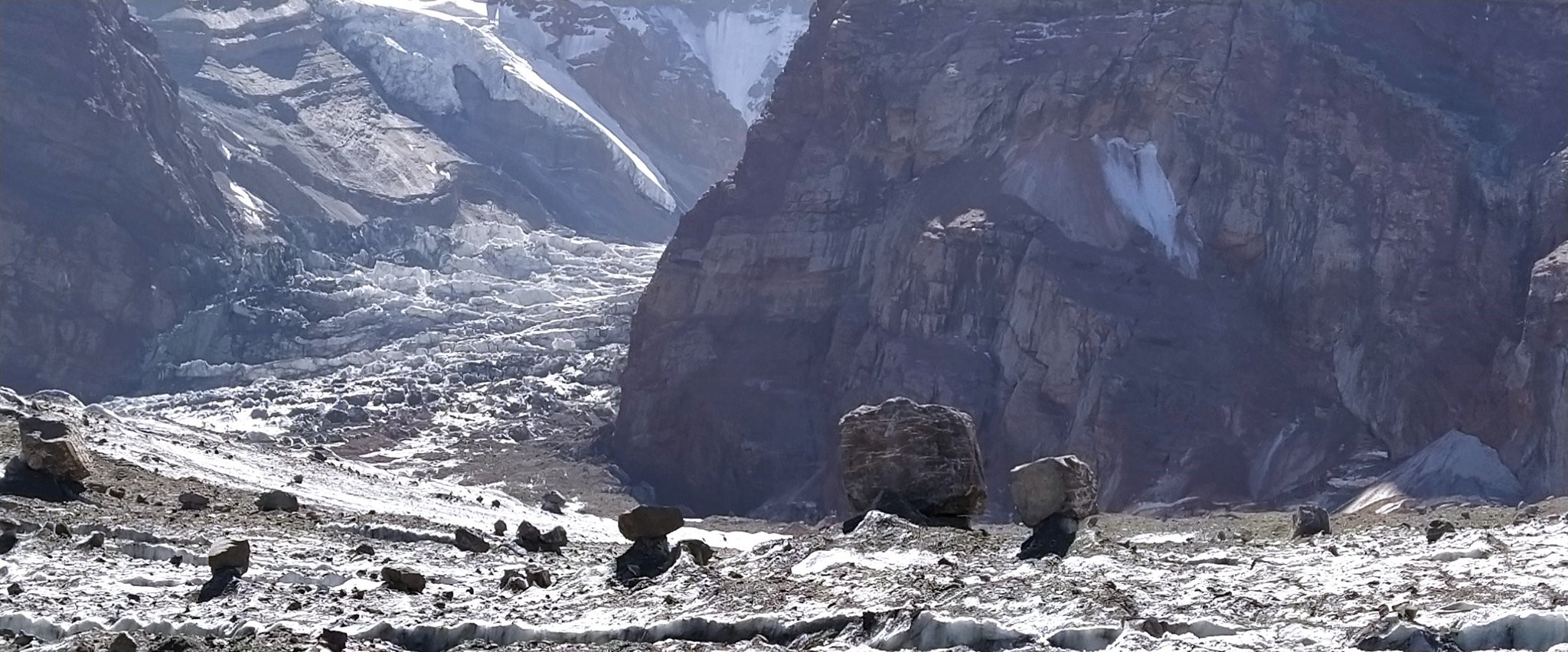The changing cryosphere of the Pamir mountains is expected to result in an increasing number of mass movements (e.g. rockslides, debris flows, glacier detachments) and Glacial Lake Outburst Floods (GLOFs). GLOFs are critically dependent on the characteristics of glacial lakes, such as lakes dammed by glacial moraines, creeping permafrost, and advancing glaciers, while outbursts from even supraglacial lakes can pose a hazard.
Research into the lake forms of the Pamir mountains, however, is essentially non-existent. For example, we know that the Pamir lakes dammed by creeping permafrost have almost no equivalent worldwide. How such lakes will evolve under a warming climate is poorly known, yet crucial for comprehensive and future-orientated GLOF hazard assessment.
As glaciers retreat over the course of the 21st century, existing proglacial lakes are projected to advance, and new lakes will develop in newly-exhumed depressions. The increasing proximity of these lakes to steep mountain headwalls suggests increasing potential for catastrophic rock slides cascading into glacial lakes, leading to outburst events. This is of particular concern given expected permafrost degradation and reduced stability of headwall slopes over time.
Even in the absence of a glacial lake, large rock-ice slides can generate enough water from frictional melting to generate devastating floods far downstream. While our understanding of such events is limited to the recent past, the Pamir hosts several extremely large prehistoric rock slides, for which ages and triggering mechanisms remain mostly unknown. The interdisciplinary nature of the PAMIR programme will allow us to constraint the age of such events through field and lab-based analyses and to relate landslide activity with possible triggers e.g., seismic or climatic conditions.
The Pamir is also one of the few locations globally where massive large-volume detachments of low-angled glacier tongues have been observed. Research on this phenomenon is still in its infancy, and processes that drive these events are not well established. Locally clustered events indicate that the Petra Pervogo range (NW Pamir) has particularly favorable conditions for such events, making it a unique natural laboratory. The comprehensive new cryospheric data being collected under PAMIR will, therefore, significantly improve understanding of the factors driving detachments, and in particular, the role of subglacial thermal and hydrological conditions.
Overall, we hypothesize that cryospheric mass movement and GLOF activity in the Pamir are primarily governed by thermal characteristics at the glacier bed and within permafrost landforms, and are highly sensitive to past and future climate change. Building on the unique chance offered by this interdisciplinary initiative, we hope to provide the first benchmark understanding of the complex interactions among changes in the climate, cryosphere, and related hazard processes in the Pamir.
Cluster Participants
Simon Allen, Senior scientist, UZH and UNIGE. Cluster PI.
Mylène Jacquemart, Postdoc, ETHZ. Investigation of large glacier detachments.
Alessandro Cicoira, Postdoc, UZH. UAV monitoring and hazard modelling.
Holger Frey, Senior scientist and secretary of GAPHAZ, UZH. Hazard modelling and early warning.
Christian Huggel, Professor, UZH. Hazard assessment, GLOFs and glacier collapse.
Alberto Muñoz, PhD candidate, UNIGE. UAV monitoring.
Silvia Piccinelli, Professor, Franklin University, Dendrogeomorphology for permafrost and hazard processes.
Laura Niggli, PhD candidate, UZH. Field studies of lake dams.
Markus Stoffel, Professor, University of Geneva. Hazard assessment and debris flows.
Jonas Laube, MSc student, UZH.
Local Partners
Roy Sidle, Director of Mountain Societies Research Institute and Professor of Earth and Environmental Sciences, UCA, Tajikistan. Expert on landslides, debris flows, and hazard assessment.
Rustam Nazarzoda, COESCD, Tajikistan. Logistical support, interface with local stakeholders.
Hadi Husani, Head of AKAH, Tajikistan. Logistical support, interface with local stakeholders, coordination of permafrost and hazard related activities.
Zaynura Khudoyorbekova, AKAH, Tajikistan. Logistical support, interface with local stakeholders, coordination of permafrost and hazard related activities.
Ruslan Bobov, AKAH, Tajikistan. Head of Operational Research & Technical Department.
Dustzoda Dilovarsho Saidahmad, Director, Tajikgidromet, Tajikistan.
Muzaffar Shodmonov, Project Manager, Tajikgidromet, Tajikistan. Agency partner for snow surveys and hazard assessment
International Partners
Martin Mergili, Professor, University of Graz, Austria. Modelling of cascading mountain hazards.
Dmitry Petrakov, Professor, MGU, Russia. Cryospheric hazards and link to local scientists.
